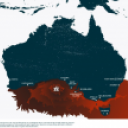The coalface


Geez , Craig you don’t mind an adventure ! Hat’s off mate , good to see you grabbing life by the short and curlies. You only get one shot ( in your current corporeal form ).
Meanwhile.....the Aussie spirit bounces back !
Photo taken at friends house on the South Coast. They fought the fire themselves as it threatened their house. They lost a shed , a shithouse and a vege garden but they saved their house and their lives.



Thanks Craig, seen destruction like that in the Otways twice, at Kinglake and in the Marysville - Lake Mountain area (all Vic). The silence of the forest really hits me. It takes years and years (decades?) to come back, in Marysville the fires were so hot all the grandmother giant mountain ash were killed off so that’s 100s of years of growth. Those canyons you were in, near Katoomba or Black Heath or elsewhere? my knowledge of the geography of the area isn’t all that great having only there three times in the last 5 years.


We took our kids for a walk through the local forest reserve this weekend, which they've grown up roaming around since they could first walk. The fire was at its hottest through there, crowning through the eucalypt forest with an intensity that is apparent even now, two months after the event. There were signs of life coming back - new leaves, a skink here and there, and a thousand tiny wattle seedlings sprouting. But the birds haven't come back. We only saw one pigeon, and that was out on the edge of the park. Silence everywhere else. I guess there's nothing to come back to, just yet.
One hopeful sign though was the mob of about 10 roos we spooked as we came around a bend in the path. They'd survived the flames and had come into the park to take advantage of all the new green grass shoots that have begun to emerge since last month's unseasonal rainfall.
Meanwhile, I've been engaged in a bit of guerilla planting up the roadside verge above our place. I've rehoused a patch of agave that had outgrown its pot on our deck. Hardy, drought tolerant and fire resistant, plus I'll be able to make surfboards out of the flower stalks in another 20 years or so.


Any landslides up there Craig? In the escarpments of the Mid North Coast NSW where there were intense bushfires followed by heavy rain and down pours there is lot of soil, boulders, logs and ash that has no vegetation to retain it being washed down the slopes and making a terrible mess of the roads and creeks.


one good thing about being a surfer is that you have nice old wetsuits for canyoning. while everyone else is cold in their $40 wetty from target.
i don't want to see the destruction. i'm so depressed as it is.
i've been bushwalking and rock climbing for 40 years, and
every single place i've ever camped has been burned -- yengo, garden of stones, wollemi, colo, kanagangra boyd, wild dogs, barrington tops, budawangs, snowy mountains -- kiandra is all gone, including the beautiful four mile hut. jugungal, geehi.
easter is the traditional start of the bushwalking season. but i have no idea where to go. it's all gone.


Don’t be depressed , Chook.
It’s hectic but it’s the cycle of life. Mourn as you need to and then go and appreciate the rebirth.


Here's a decent one of the Tambo in east gippy



Carpet man, That’s a great image. Didn’t see anything on that scale but same sort of debris flow, smothering what were once clear running creeks.









Following on the lines of Stu's experience here.. https://www.swellnet.com/comment/648713 I've written this piece from a recent trip to the northern Blue Mountains...
Deeply troubling: Now that the rain's extinguished most of the fires throughout the state and every thing has turned a nice shade of green, it's easy to forget the horror of what we've seen in the months prior.
After seeing all the videos, photos and updates from across the fire grounds I thought I had a fairly decent grasp on the devastation and loss of wildlife, it's been an emotional couple of months, but nothing compares to seeing it first hand.
Sunday, I travelled to the Blue Mountains, into the area impacted by the Grose Valley Fire.
Wiped out – that's the only way to describe it, the scene is that of pure horror. There's nothing left on the ground, no bugs, no birds, no wildlife, just the odd ant hill. Kilometre upon kilometre of bushland with bare blackened trees. The loss is incomprehensible and the time it's going to take for it to rejuvenate, not years but decades.
We were going canyoning, deep into the darkest, coldest and dampest parts of the Blue Mountains and sadly, not even these spots escaped the ferocity of the fires. While a lot of the canyons are still filled with lush green ferns, moss and water, just atop the black tar like top soil seeps down over the edges, and the more open sections have been totally decimated.
Where there were tree canopies, shade, moisture and life, there is now, black, light, open space and dead wood. One can now see for kilometres across valleys and easily route find, but the impact on the ecosystems and also change in the carbon budget over such mass landscapes is going to be felt for years to come.
There are signs of new life and green, the most resilient being the ferns, and ants roaming the ground, but all the other millions of insects, bugs and worms.. they're yet to be seen.
I highly recommend going for a drive and walk through these landscapes as it's something I've never personally experienced or felt before.